midcoast DESTINATION MANAGEMENT PLAN 2030


Acknowledgement of Country
We acknowledge the traditional custodians of the land on which we work and live, the Gathangspeaking people and pay our respects to all Aboriginal and Torres Strait Islander people who now reside in the MidCoast Council area. We extend our respect to Elders past and present, and to all future cultural-knowledge holders.
2 MidCoast Destination Management Plan 2030
Contents Executive Summary 5 01 Introduction 6 Destination Barrington Coast 7 MidCoast Destination Management Plan 2030 9 Destination Management Plan Framework 10 02 Strategic Context 12 Existing and Emerging Strengths 13 Measures of Success 14 Targeting the Right Visitor Markets 16 International Markets 20 A More Sustainable Environment – Protecting and Enhancing Environmental Values 21 Unbalanced Tourism 22 Importance of Collaboration, Partnerships and Personalisation 23 03 Implementation Plan 24 Enablers 25 Supply 29 Demand 38 04 Appendix: Situation Analysis 41 NSW Visitor Economy Strategy 2030 43 Destination North Coast’s Destination Management Plan 2022 - 2030 44 Target Markets 46 3 MidCoast Destination Management Plan 2030
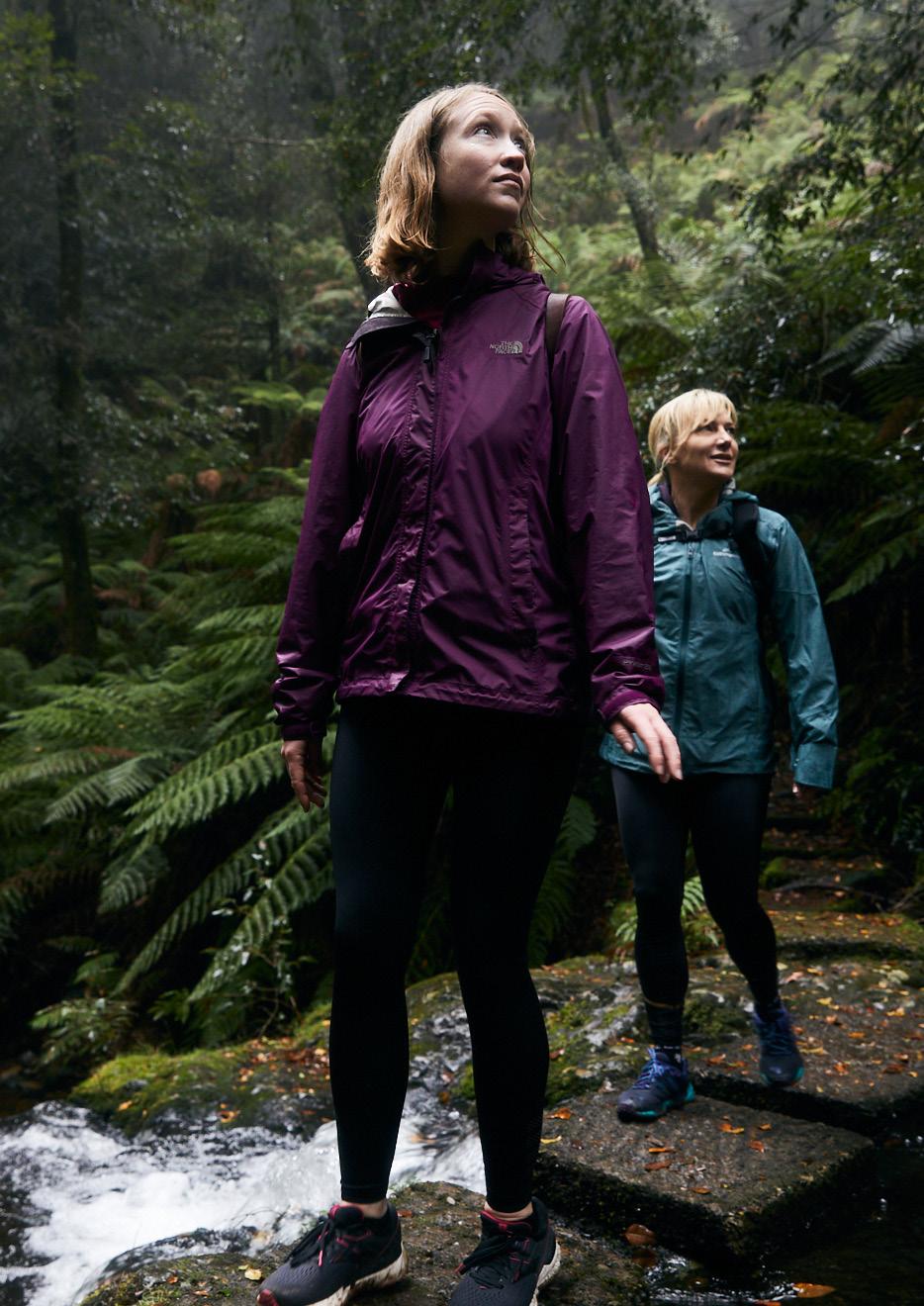
Executive Summary
The MidCoast Destination Management Plan 2030 (DMP2030) sets the direction and prioritises the sustainable growth of the visitor economy of the MidCoast Council Local Government Area to 2030 and beyond.
It includes a practical and prioritised two-year implementation plan that supports regional promotion, visitation and prosperity, while addressing the barriers and challenges faced by the region. Importantly, it is a plan for the whole destination, not individual businesses or operators. It aims to foster a vibrant visitor economy and promote liveability, delivering tangible benefits to businesses, residents and our visitors.
The MidCoast Destination Management Plan 2017 helped to set the foundation for the growth of the MidCoast as a destination through the implementation of the Destination Barrington
Coast brand and associated marketing campaign. The brand has been successful in raising awareness and providing exposure for the region.
DMP2030 builds on the extensive work that has been completed since the previous destination management plan and has been developed in consultation with a range of local, state and federal stakeholders. It provides a strategic framework and guiding principles that will enable the region’s development of the visitor economy. DMP2030 focuses on outcomes which aim to drive a fundamental shift in capability and capacity for the MidCoast tourism industry.
DMP2030 is designed to address three core strategic priority areas that will ensure the delivery of the specific goals set out in the Implementation Plan:
• ENABLERS: priorities that assist and enable implementation.
• SUPPLY: enhancing the region’s current product offering and attracting new products and experiences.
• DEMAND: marketing and visitor servicing to drive increases in visitor nights and expenditure and seasonal dispersal.
DMP2030 has been informed by a comprehensive situation analysis, including global and domestic trends, visitor research and range of existing local, state and national strategies and policies (Refer to Appendix).
Appreciation to all involved
The development of this plan is the result of a comprehensive process. There were many people involved, representing MidCoast Council, local, regional and state-wide stakeholders, local businesses and the region’s community. The insights so generously shared have informed and helped shape this document.
The MidCoast Council Destination Management Plan Review Reference Group assisted to guide the direction of the DMP2030 and has provided valuable insight to enable the development plan.
5 MidCoast Destination Management Plan 2030
Introduction
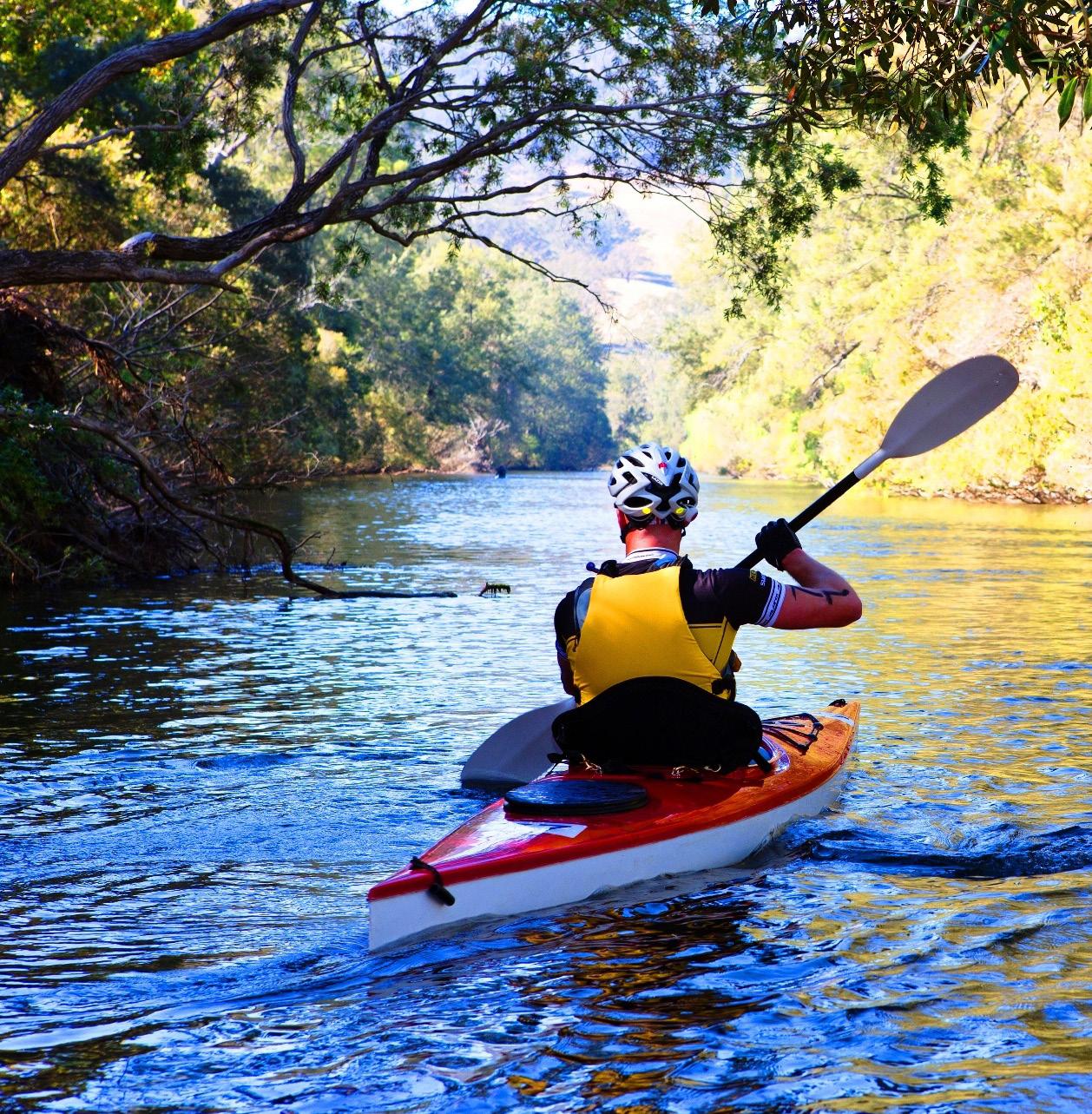
01
Destination Barrington Coast
The Barrington Coast spans over 10,000km2 and boasts a world heritage mountain range at this highest point.
At the Barrington Coast’s southernmost tip, you’ll find Hawks Nest and Tea Gardens; less than 2.5 hours drive from Sydney’s northern suburbs. A further hour north will bring you to Pacific Palms, Forster-Tuncurry or Gloucester. If you travel westwards to the highest point of the Barrington Coast you can explore the ancient Gondwana Rainforests of World Heritage Barrington Tops.
We’re famous for our forests, waterways and beaches. We have 15 national parks plus 63 state forests, nature reserves and conservation areas. Our lands are watered by 38 rivers including the Manning River, the only double delta river system in the southern hemisphere; as well as the state’s tallest single drop waterfall at 200m, Ellenborough Falls.
We also enjoy a pristine triple lakes system and over 190kms of absolutely stunning coastline.
PACIFIC OCEAN MANNI NG RIV ER WYONG R I V E R SALISBU MYAL L R I V E R GLOUCESTERRIVER NOWENDOCRIVER MB I BROOK BARNARDRIVER KARUAHRIVE R P A T E R S O N RIVER APSLEYRIVER WILLIAMSRIVER PE E L R I VER MACDONALD R I VE R H A S T I N G S RIVER MACLEAYRIVER HUNTERRIVER
Bar
Gardens
Stroud
Lansdowne TAREE GLOUCESTER FORSTER TUNCURRY NEWCASTLE
MACQUARIE 7 MidCoast Destination Management Plan 2030
Old
Harrington Tea
Bulahdelah
Wingham
PORT
KEY STATiStics
DOMESTIC OVERNIGHT 1.24 m
(Sept 2023)
5.7% increase from previous year
daytrip 938 k
(Sept 2023)
0.3% decrease from previous year
Total visitor numbers 2.18 m
(Sept 2023)
3% increase from previous year
Industry value-add $168.4 m
DOMESTIC OVERNIGHT EXPENDITURE $666 m
(Sept 2023)
12% increase from previous year
daytrip expenditure $145 m
(Sept 2023)
47.9% increase from previous year
Total tourism expenditure $811 m
(Sept 2023)
17.5% increase from previous year
(June 22) increase of 11.9% from previous year
8 MidCoast Destination Management Plan 2030
MidCoast Destination Management Plan 2030
The MidCoast Destination Management Plan 2030 sets the direction and prioritises the sustainable growth of the visitor economy of the MidCoast Council Local Government Area to 2030 and beyond.
It includes a practical and prioritised two-year action plan that supports regional promotion, visitation and prosperity while addressing the barriers and challenges faced by the region. Importantly, it builds on the extensive work done since the previous plan, which was finalised and launched in 2017. This plan supported the development and implementation of the Destination Barrington Coast brand and associated marketing campaign.
During stakeholder consultation in the development of DMP2030, a set of guiding principles were established to ensure a balanced approach was taken to delivering objectives. These are:
1. Inclusive of the whole region and all communities
2. Informed and evidence-based
3. Showcasing the destination’s existing and emerging strengths
4. Customer-centric - putting the visitor first
5. Future-focused and sustainable - understanding a dynamic industry and the importance of protecting the destination’s values and attributes
6. Fostering collaboration across sectors and between industries and stakeholders
7. Demonstrating leadership through effective implementation, partnerships and communication - including through alignment with NSW Visitor Economy Strategy 2030
8. Measurable in terms of both deliverables and outcomes
Evaluating success
DMP2030 represents the next stage in evolving the region’s visitor economy and keeping pace with a dynamic industry and marketplace. As a result, it should be reviewed and updated across its lifespan, from 2024 to 2030 and beyond. The associated Implementation Plan 2024-2026 will be reviewed every two years.
Measuring and evaluating success is critical to highlight where strategies and actions can be adjusted over time to ensure they remain relevant and effective.
9 MidCoast Destination Management Plan 2030
Destination Management Plan Framework
Ambition
The Barrington Coast is celebrated as a leading sustainable destination where outstanding natural beauty meets vibrant country living, inspiring healthy and active lifestyles.
Purpose
Provide a prioritised roadmap for the continued sustainable growth of the MidCoast visitor economy.
THEMES CREATE A VIBRANT AND VIABLE VISITOR ECONOMY ENABLERS
HIGH LEVEL OBJECTIVES
• Foster a broad base of support for the visitor economy
• Lead genuine and effective industry engagement
• Ensure the region’s natural and cultural values are protected, sustained and enhanced
MEASURES
• Increase low and shoulder season as well as encouraging mid-week visitation
• Increase overnight visitor yield, year-round
• Increase the supply of paid visitor experiences and events
• Lead genuine and effective industry engagement
1.1 Build a broad base of support for the visitor economy with residents and local businesses as well as across all areas of Council
1.2 Facilitate genuine and effective industry engagement
1.3 Protect, sustain and enhance the region’s natural and cultural values
1.4 Strengthen collaboration and partnerships
ACTIONS
1.5 Foster and facilitate a strategic approach to attracting investment and talent, including grant funding
1.6 Advocate to address constraints and barriers to the sustainable growth of the visitor economy
10 MidCoast Destination Management Plan 2030
INCLUSIVITY AND SHARED BENEFITS
BALANCE THE NEEDS BETWEEN GROWTH AND SUSTAINABILITY
SUPPLY DEMAND
• Increase the supply of paid visitor experiences and events
• Attract and enable investment for infrastructure projects and facilities that deliver shared benefits
• Attract investment in sustainable, nature and cultural tourism experiences, accommodation and hospitality
• Encourage greater regional visitation and visitor spend dispersal
• Attract and enable investment for infrastructure projects & facilities that deliver shared benefits
• Foster a broad base of support for the visitor economy
2.1. Co-design of a model for encouraging, supporting and developing First Nations cultural experience
2.2. Implement a product and experience development program
2.3. Attract new events and help build capacity of local events
2.4. Attract investment for infrastructure and facilities that deliver shared benefits for residents and visitors
2.5. Attract investment in sustainable, nature and cultural tourism experiences, accommodation, and hospitality
2.6. Encourage diversification and revitalisation of accommodation supply
2.7. Game changer projects for the region
• Increase low and shoulder season as well as encouraging mid-week visitation
• Increase overnight visitor yield, year-round
• Encourage greater regional dispersal
• Attract investment in sustainable, nature and cultural tourism experiences, accommodation, and hospitality
• Ensure the region’s natural and cultural values are protected, sustained and enhanced
3.1. Continued commitment to the Destination Barrington Coast brand and positioning, Blaze your own trail
3.2. Create a destination marketing plan to guide all marketing and marketing-communication activities
3.3. Raise the awareness of the Destination Barrington Coast brand with local businesses and community
3.4. Continue to deliver visitor services across the region
3.5. Continue to support the growth of the Visiting Friends & Relatives (VFR) market
IMPLEMENTATION PLAN 11 MidCoast Destination Management Plan 2030
Strategic Context

02
Existing and Emerging Strengths
Over recent years and despite the challenges brought by COVID-19 and significant natural events (such as bushfires and floods), the awareness and appeal of the Barrington Coast as a short break and holiday destination has continued to strengthen.
This is primarily the result of focused marketing efforts that have profiled the natural beauty and nature-based offering of the region and events. These campaigns have resonated with target markets, their expectations and desires.
There is little doubt that a clear strength of the region relates specifically to its nature-based setting, including the myriad waterways, its spectacular coastline and beautiful hinterland and valleys. The region is blessed with national parks of international significance due to their conservation values. Myall Lakes National Park is internationally recognised under the Ramsar Convention for its diverse natural wetlands within a relatively unmodified coastal lake system. Barrington Tops National Park forms part of the Gondwana Rainforests of Australia World Heritage Area.
While nature is accessible throughout the region, the paid visitor experience offering is still emerging. Encouraging the growth of experiences that provide different ways for different audiences to engage with and access nature (in all its forms) is a priority for further development. Accommodation that provides direct access to or immersion in nature, such as caravan and camping as well as boutique accommodation is a further strength of the region.
There are also a number of other strengths that have emerged over recent years. This includes:
1. The region’s abundance of high-quality produce. The MidCoast is inundated with great produce from local farms and the sea, it is however not easily available to visitors. Culinary tourism is another emerging strength that would continue to enhance the appeal and preference for Destination Barrington Coast.
2. A local community who actively welcomes the market known as Visiting Friends & Relatives (VFR). The VFR market offers significant advantages, including that they are more trusted and respectful visitors and are more likely to visit outside of peak season or periods.
3. The MidCoast region has a rich and significant First Nations history. This is seen as a strength and provides an opportunity to build local capability in creating new cultural and historical tours.
4. Proximity to the region’s core source markets of Sydney and Newcastle. This proximity was further amplified during the COVID-19 period and is likely to remain in focus during uncertain economic times, with cost-ofliving pressures reducing budgets but not appetites for travel and holidays. It is also a great advantage when younger generations, including both Gen Z and Millennials, are choosing to travel more frequently for short breaks. The opportunity for more flexible working arrangements means people are looking to escape for longer short breaks. The closer to home that they can achieve a sense of freedom yet still be connected (for at least some part of their trip) is likely to continue strengthening the appeal of destinations such as the Barrington Coast.
5. An enlivened and diverse year-round events program, which covers themes as diverse as sports to the arts, music, produce and food and drink. This plays into the clear trend for visitors to investigate ‘what’s on’ as part of their trip planning.
This plan seeks to capitalise on these existing and emerging strengths to continue evolving and enriching the visitor economy of Destination Barrington Coast.
13 MidCoast Destination Management Plan 2030
Measures of Success
Increase domestic overnight visitation to numbers seen pre-COVID
Increase domestic day trip visitation to numbers seen pre-COVID
Increase visitor expenditure
1: CREATE A VIBRANT AND VIABLE VISITOR ECONOMY
Increase low and shoulder season as well as encouraging mid-week visitation
Increase overnight visitor yield, year-round
Increase the supply of paid visitor experiences and events
Increase of 10%* overnight visitation on 2019 data by 2030 for low and shoulder season and mid-week
Increase of 10%* overnight visitor spend on 2019 by 2030
• Increase paid experiences by 20% on Australian Tourism Data Warehouse (ATDW)-listed experiences, events or attractions between 2024 to 2030
• 3 new First Nations experiences created and operating by 2030
• Increase in the number of packages involving existing tourism providers
• Increase the number of wellness, agritourism and farmgate experiences.
Lead genuine and effective industry engagement
• Establish an ongoing Industry Advisory Group, which meets a minimum of 4 times per year
• Host a minimum of four networking sessions for industry annually, in partnership with Destination North Coast NSW / Destination NSW (DNC/DNSW)

PERFORMANCE INDICATORS OR OUTPUTS DELIVERED
THEMES KEY
THEMES
KEY PERFORMANCE INDICATORS OR OUTPUTS DELIVERED
2 : INCLUSIVITY AND SHARED BENEFITS
Encourage greater regional visitation and visitor spend dispersal
Attract and enable investment for infrastructure projects and facilities that deliver shared benefits
Increase of 10%* overnight visitor spend on 2019 across all sub-regions by 2030
Attract and enable investment for and implement priorities identified within:
• MidCoast Economic Development Strategy
• MidCoast Open Space and Recreation Strategy
Note: Focus will be on infrastructure and facilities planned but as yet unfunded for significant experiences
Foster a broad base of support for the visitor economy
• Continued implementation of visitor servicing actions, including activities such as educations workshops, visitor information popups.
• Maintain / increase tourism employment
3: BALANCE THE NEEDS BETWEEN GROWTH AND SUSTAINABILITY
Attract investment in sustainable, nature and cultural tourism experiences, accommodation, and hospitality
Ensure the region’s natural and cultural values are protected, sustained and enhanced
KEY:
• 15% increase in new sustainable tourism^ experiences and accommodation by 2030
• 30% increase in the number of existing tourism businesses and accommodation providers achieving sustainable tourism^ accreditation or certification by 2030
• 3 new First Nations experiences created and operating by 2030
• MidCoast Council achieves green destination accreditation by 2026
• MidCoast Council implements an annual program involving a proactive approach to managing unbalanced tourism at specific sites during peak season
* Adjusted for CPI to take account of inflation over the period 2019-2030. Note: Given the unpredictable fluctuations in the visitor economy due to COVID-19, the 2019 data is being used as a baseline unless otherwise stated eg VFR TRA data from 2022.
^ Sustainable tourism businesses are defined as those that have achieved appropriate accreditation or certification (eg Ecotourism Australia (EA) or Earth Check programs) or completed programs such as EA’s Sustainability Scorecard with a satisfactory rating.
15 MidCoast Destination Management Plan 2030
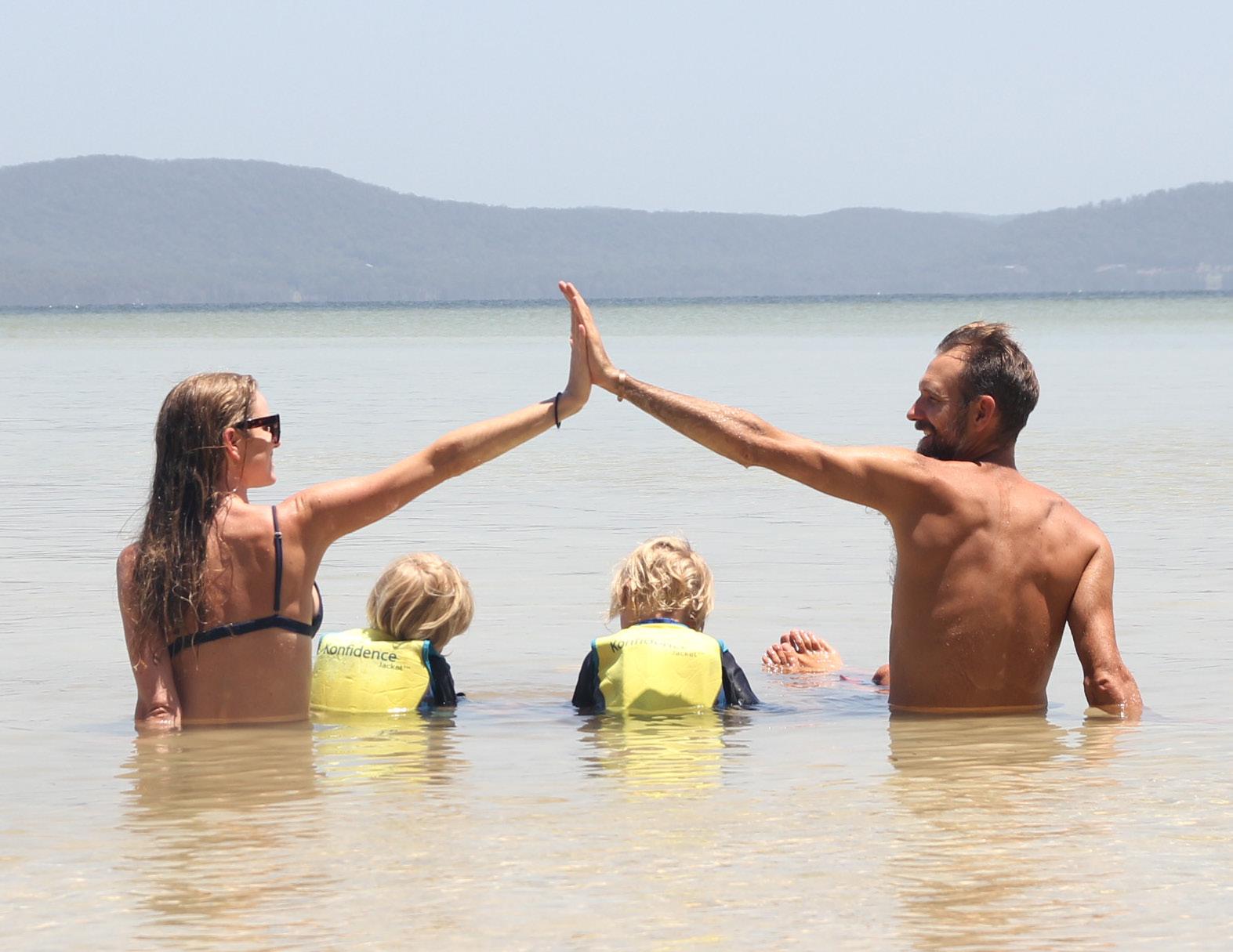
Targeting the Right Visitor Markets
A critical success factor is maintaining our current market segments, whilst attracting the new visitor markets, who will enjoy their Destination Barrington Coast experience and become advocates for the region. While there are many markets that will be attracted to the region and its diverse experience offering, as a destination it is critical to identify and target those market segments with the greatest propensity to visit the destination, year-round.
Existing markets – strengthen the appeal of the destination to existing markets to:
• Extend length of stay
• Encourage repeat visitation
• Increase participation in tours and activities (paid experiences)
• Increase regional dispersal (especially during peak periods)
Emerging markets – focus on those markets with the greatest propensity to grow the visitor economy:
• Increase visitation during non-peak periods
• Increase yield (through development of higher-yield experiences and accommodation offer)
16 MidCoast Destination Management Plan 2030
The MidCoast region has several emerging and evolving markets, specifically:
• Active families are attracted to a destination that offers happy, healthy, sustainable and safe family adventure. This trend has seen a significant growth in more recent years, particularly following the COVID-19 travel restrictions and lockdowns. They seek opportunities for their children to experience the great outdoors and self-select a break from screen time by providing a fun and exciting alternative. This increasingly includes short breaks as well as aligning with the significant growth in demand for caravan, campervan and camping accommodation and facilities. The region is well positioned to offer this type of holiday.
• Millennials and Gen Z continue to travel more domestically than previous generations of their age. This market is highly likely to be attracted to the region as they seek more sustainable, nature-based destinations that offer a variety of accommodation, quality food and drink establishments and contemporary arts and cultural experiences. They travel in couples or small groups of close friends, avoid older-style youth hostels and desire to experience a destination ‘like a local’ (ie seek out local experiences). Millennials are also travelling with their young families and seek out more experiential travel opportunities that engage the whole family, including through increased demand for camping, caravan and campervan and short-term rental accommodation.
• Digital nomads and the remote working revolution. Even though this market is relatively small it is growing rapidly. This market is seeking places that have connectivity (for ease of remote working), opportunities for short-term rental accommodation and co-working space, as well as activities and experiences to do while they are in the region. They can also create short term VFR opportunities. The remote working market want to feel like a local for the time they are in your town, village, or region. They want to be part of the community and short-term rental accommodation is high on their list of accommodation choices/options.
• The continuing evolution of the fifties plus market. More people are choosing to travel earlier than retirement to enjoy the more active or immersive experiences that destinations have to offer. Globally, the 55+ market has the highest disposable income and are seeking new destinations to add to their bucket-list. They are as equally excited about an Australian holiday as they are about an overseas trip. This market is largely misunderstood; they want to engage and be part of the ‘local scene’. They are also much more active and want to be perceived as being ‘young at heart.’ Domestically, they are also looking for short-break escapes and often choose to travel outside of peak periods to avoid the crowds.

17 MidCoast Destination Management Plan 2030


A number of niche visitor markets have also been identified which align to the region’s strengths, including:
• Cycle tourism and mountain bike market segments – there is an increasing interest throughout Australia in opportunities for cycle tourism.
Given the recent investment in mountain bike trails in the region, there is an opportunity for the Barrington Coast to further strengthen its appeal to cycle tourism markets, especially for mountain biking and gravel bikes. However, it will be important to consider who the target audience should be. For mountain biking, it is most likely the mountain biking leisure segment, who are more likely to have a mountain bike experience while taking a holiday. However, specific experiences such as those associated with Kiwarrak State Forest Mountain Bike Park and The Steps Barrington and Barrington Bike Park are more likely to attract the mountain bike enthusiast segment, who will travel for the primary purpose of a mountain bike experience.
The opportunity for collaboration with the Hunter Joint Organisation (HJO) on the development of the Hunter Cycle Tourism Strategy, which will incorporate the MidCoast Council region should be given further consideration.
• The continuing rise in the numbers of contemporary female travellers, who are more likely to have a higher disposable income and to travel either on their own or in small groups of friends. They are also key influencers in family travel and seek new experiences that immerse them in the destination and local culture.
• Business Events – small scale, boutique events. Even before COVID-19, there had been a significant shift in business events. This shift has been away from large-scale conferences towards more tailor-made, smaller-scale business events. Another important shift has been towards hosting these events in destinations that have more to offer than the standard conferencing facilities. Specifically, an experience offering that can be shared and enjoyed by participants.
These market segments represent the sweet-spot between psychographic and demographic or generational market segments. They leverage the existing and emerging strengths of the region. Importantly, these emerging markets are already arriving, and while they could be classified as ‘existing’ they are still an emerging market opportunity for the region.
In addition, the VFR market remains a high priority. This market is already significant and is important to the region’s visitor economy year-round. It is critical to remember that the primary target audience of the VFR market is the local host, who plays a major influence on the market’s travel decisions.
19 MidCoast Destination Management Plan 2030

International Markets
International visitors to the Barrington Coast are currently a very low proportion of total annual visitation to the region. However, a number of emerging opportunities may enable us to grow awareness of and a preference for the Barrington Coast with international markets.
Specifically, the HJO has received funding for the Hunter Global Tourism Project, to leverage the investment in, and expansion of, the Newcastle Airport to welcome international arrivals. It is most likely that the international markets that would be interested in the Barrington Coast will be:
• Free and independent travellers who are visiting Australia for the second or third time; and
• International Visiting Friends and Relatives, who may be returning home or visiting friends or family who now reside in the region or within key domestic source markets to the Barrington Coast (eg Greater Sydney or Greater Newcastle areas).
MidCoast Council will continue to collaborate with the HJO on the development of the Hunter Global Tourism Project to identify and pursue opportunities to grow international visitation to the Barrington Coast. This will be a longer-term outcome and would benefit from growth in the availability of international-ready products, experiences and accommodation (to suit the preferences of these market segments) across the region.
20 MidCoast Destination Management Plan 2030
A More Sustainable Environment – Protecting and Enhancing Environmental Values
A clear theme that has emerged through consultation and multiple forums relating to Council’s policy, planning and program initiatives, is the importance of protecting and enhancing the region’s outstanding environmental values.
This is motivated by several reasons, from simple aesthetics to opportunities for outdoor recreation and the importance of a quality natural environment to support agricultural industry and productivity, including but not limited to oyster farming.
As a result, it is critical that any development and place planning is undertaken with these values and sense of place at the centre of decision-making. This includes proactive management of environmental values and sensitive sites as well as building a greater understanding of management priorities to enable protection and enhancement of the region’s natural environment. This will be done in line with the principles of adaptive management, as articulated in MidCoast Council’s Planning Framework.
A clear benefit of this approach is to enable and encourage active lifestyles and health and wellbeing, including the development of active transport initiatives and corridors that link open space, sporting and recreation facilities with town centres and other important assets, facilities and infrastructure in the region. This should enable better access to the destination’s natural assets, encourage greater dispersal and align with the growing trend for wellness tourism.
MidCoast Council has already developed plans, strategies and programs that specifically address environmental management and protection of the environment, including:
• MidCoast Greening Strategy
• Manning River Estuary Catchment and Management Program 2021 - 2031
• MidCoast Council Climate Change Strategy
• MidCoast Council Biodiversity Framework 2021-2030
• MidCoast Waste Management Strategy 2030
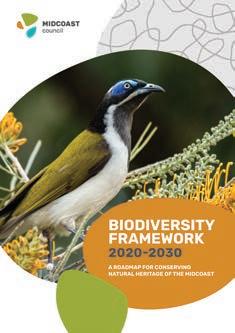


21 MidCoast Destination Management Plan 2030

Unbalanced Tourism
Associated with this priority is the challenge of proactively managing the impacts of unbalanced tourism. If this is not done effectively, it contributes to undermining both the perception and reality of the region’s natural beauty, assets and sustainability.
Unbalanced tourism occurs when there are too many visitors to a particular site or location within a destination, resulting in negative impacts on the environment, local communities, quality of life for residents as well as the visitor experience.
Managing unbalanced tourism requires a coordinated effort from multiple stakeholders, including State and Local Government, land managers, the tourism industry, local communities, and the visitors themselves.
A key to success is a proactive program that involves the community and local businesses. This can be difficult to achieve given the range of views and perceptions that are held by people with competing interests.
However, there are examples of success from around the world, particularly in highly sensitive natural environments, where an annual communication and threat mitigation approach has been implemented.

22 MidCoast Destination Management Plan 2030
Importance of Collaboration, Partnerships and Personalisation
A key to success for any destination is to foster and strengthen collaboration and partnerships within the region and beyond its borders. This in turn creates opportunities for personalisation.
The Future of Global Tourism Demand (Tourism Australia, 2022) research report, recognised the importance of collaboration and personalisation for international markets, which equally applies to domestic markets (page 15):

“Collaboration and Personalisation: travellers enjoy drawing from multiple experiences within and across sectors. Understanding the underlying patterns in traveller appeal for experiences unlocks opportunities to cross-sell experiences, … develop partnerships, … and build out compelling touring trails or itinerary packaging tailored to audience desires”
Collaboration can deliver bigger and better results by strengthening cooperation and building partnerships. Cooperation and partnerships with industry within the MidCoast region as well as external stakeholders such as NSW National Parks and Wildlife Service, NSW Forestry Corporation (State Forests), Crown Lands NSW, Destination NSW, Destination North Coast NSW, Hunter Joint Organisation , and The Caravan, Camping and Touring Industry and Manufactured Housing Industry Association of NSW (also known as the Caravan and Camping Industry Association of NSW ), are vital to success.
Shared infrastructure projects, such as those identified within the context of the MidCoast Open Space and Recreation Strategy 20232035, enable connectivity with core features of the destination, including its towns and villages and all elements of the overall experience. This will be critical to the success of major initiatives such as sports tourism facilities, multi-day walks,
mountain bike trail networks and kayaking and waterway trails, which will need to link to and help activate accommodation, tours, attractions, retail and hospitality as well as amenities and services such as parking, toilets and bike hire.
An important outcome is the creation of personalised or tailored packages or the bundling of products and experiences that meet the desires, expectations and preferences of specific target market segments. This should be core to any experience and event development program. It also provides an opportunity to integrate First Nations’ experiences into destination packages and itineraries as well as attracting the smaller-scale and boutique business events market.
Only by adopting a holistic approach will the full potential of Destination Barrington Coast’s brand and positioning, Blaze your own Trail be delivered.
23 MidCoast Destination Management Plan 2030
Implementation Plan

03
Enablers
Tourism is a dynamic industry, which means it’s essential to know the preferences, expectations and needs of today’s travellers as well as their barriers to travel. It’s also important to recognise that sometimes the little things make the biggest difference.
Long-term success starts with building a broad base of support with residents and local businesses as well as across all areas of Council. This should be coupled with genuine and effective industry engagement. These strategies provide the foundations to sustainably grow a vibrant visitor economy and enhance the livability of the region.
High level objectives
1. Foster a broad base of support for the visitor economy
2. Lead genuine and effective industry engagement
3. Ensure the region’s natural and cultural values are protected, sustained and enhanced
Priority actions to address these high-level objectives are shown in the action plan below.
1.1.1 Implement a proactive, annual communication program with residents and businesses to facilitate a more positive understanding of the value of the visitor economy to the region
1.2.1 Create an Industry Advisory (or Reference) Group that can provide advice to Council on the implementation of the DMP2030 as well as other matters relating to the visitor economy
PRIORITY ACTIONS TIMEFRAME PROGRAM PARTNERS & LINKAGES ROLE
Action 1.1 Build a broad base of support for the visitor economy with residents and local businesses as well as across all areas of Council
Establish 2024-25 Then ongoing • Business Chambers, community groups and local organisations • Identify local champions who can
benefits
to the region Lead
support and communicate the
of the visitor economy
Action 1.2 Facilitate genuine and effective industry engagement
Establish 2024-25 Then ongoing • Business Chambers • DNC • DNSW • Business Operators Lead
25 MidCoast Destination Management Plan 2030
Action 1.2 Facilitate genuine and effective industry engagement continued
1.2.2 Develop and implement an engagement and capacity development program for the tourism industry, including:
• A calendar of industry capability development programs
• Continue the regular visitor research program to provide meaningful insights into the region’s visitor economy
Commence
2024-25
Then ongoing
• Industry
• DNSW
• DNC Lead Facilitate
Action 1.3 Protect, sustain and enhance the region’s natural and cultural values
1.3.1 Continue and complete work commenced on green destination accreditation for MidCoast Council with Ecotourism Australia
1.3.2 Implement a proactive approach to managing unbalanced tourism at specific sites, including:
• Investigation of carrying capacity limits and parking restrictions during peak times
• Beach access for 4WD vehicles during peak season and during sensitive wildlife breeding seasons
• Actively encourage and support development applications for environmentally and socially sustainable developments to reinforce these principles and address or mitigate long-term impacts on environmental and community values and sense of place
• Increase communication and engagement with impacted communities of the region to build an understanding of the need for any new measures as well as involving them in potential solutions
2024-25
• Ecotourism Australia Lead
2024-25
Then ongoing
• Local community and industry involvement as required
• Links to MidCoast Open Space & Recreation Strategy 2023 - 2035 Lead Advocate
PRIORITY ACTIONS TIMEFRAME PROGRAM PARTNERS & LINKAGES ROLE
26 MidCoast Destination Management Plan 2030
1.3.2 continued
• Identify options (infrastructure, facilities, ancillary services, and access corridors) to enable active transport access to key sites to reduce the pressures caused by vehicle access, especially but not exclusively during peak periods
Action 1.4 Strengthen collaboration and partnerships
1.4.1 Continue regular communication with other stakeholders involved in the NSW North Coast.
• Work with NSW National Parks and Wildlife Service (NPWS), Forestry Corporation and Crown Lands NSW to progress and support major landscape-scale and significant projects involving multiple tenure as well as facilitating greater waterway access and activation
• Continue regular engagement with Commonwealth and State Government agencies with program or land management responsibilities within MidCoast Council
Ongoing
• DNC
• HJO
• DNSW
• DRNSW
• NPWS
• Forestry Corporation NSW
• Crown Lands NSW
• TIDE
• Business Chambers
• Industry
Lead
Advocate
Action 1.5 Foster and facilitate a strategic approach to attracting investment and talent, including grant funding
1.5.1 Provide advice and support to local businesses, organisations and community groups on available visitor economy or grants that can assist them grow, revitalise or enhance their experience or offering
1.5.2 Identify infrastructure projects that enhance experiences in Barrington Coast. Ensure customercentric design and the costs associated with attracting investment are built into all proposals for new major projects. This includes robust master planning, feasibility and return on investment analysis
Ongoing
• Industry Advisory Group
• DNC, DNSW, DRNSW & other government agencies
• Links to MidCoast Economic Development Strategy 2023 - 2028
Ongoing
• Industry Advisory Group
• DNC, DNSW, DRNSW & other government agencies
• Links to MidCoast Economic Development Strategy 2023 - 2028
Facilitate
Lead
PRIORITY ACTIONS TIMEFRAME PROGRAM PARTNERS & LINKAGES ROLE
27 MidCoast Destination Management Plan 2030
Action 1.6 Advocate to address constraints and barriers to the sustainable growth of the visitor economy
1.6.1 Work with industry to identify significant constraints on sustainable growth of the visitor economy, including staff shortages, housing supply, road access and maintenance and technology, such as mobile and internet connectivity
Ongoing
• Industry Advisory Group
• Business Chambers
• Industry
• Relevant State Government agencies Lead Advocate

PRIORITY ACTIONS TIMEFRAME PROGRAM PARTNERS & LINKAGES ROLE
28 MidCoast Destination Management Plan 2030
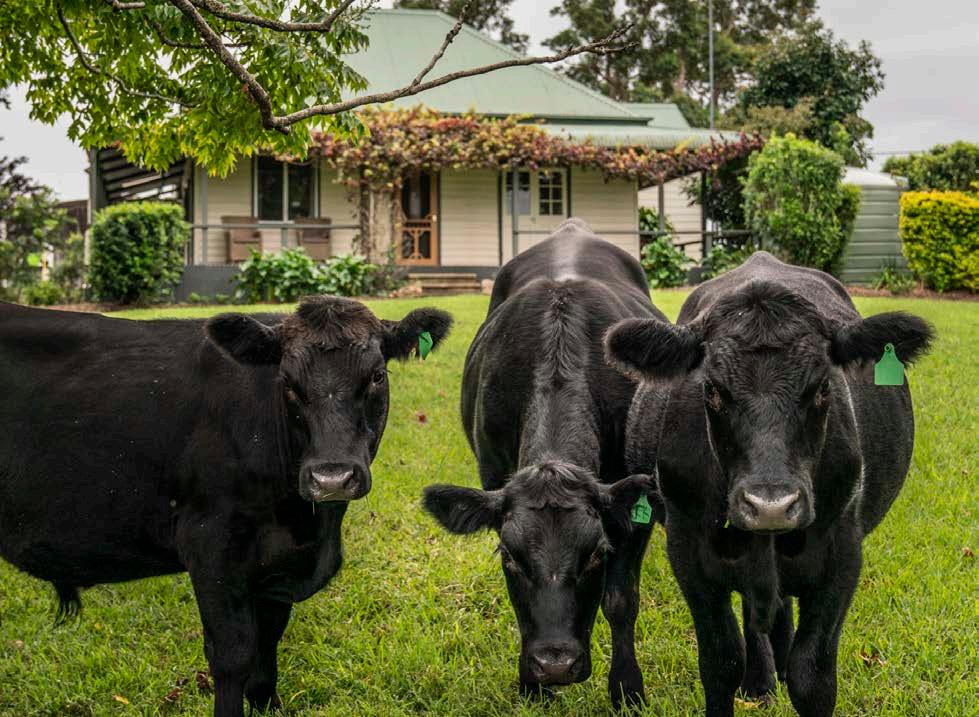
Supply
A significant challenge identified for Destination Barrington Coast is the lack of paid visitor experiences, such as guided tours and activities as well as agritourism experiences that take advantage of the region’s spectacular nature and rural setting.
A priority area is to activate and increase access to the region’s waterways, including rivers, lakes and ocean. Enhancing experientially focused itineraries and packages is a first step towards growing the experiential travel offering and increasing the awareness and appeal to high value travellers. This also links to culinary and agritourism.
Investment in shared infrastructure is also important, including connectivity between town centres, community assets and attractions, and the surrounding nature-based offering (from beaches and waterways to national parks and the World-Heritage listed Barrington Tops). This includes cycleways, walking trails and waterway access, as well as outdoor event spaces. Importantly, ancillary infrastructure or facilities, including parking, pedestrian access, and toilets should be integrated into a landscape-based approach to place planning.
High level objectives
1. Increasing the supply of paid visitor experiences and events
2. Attracting and enabling investment for infrastructure projects and facilities that deliver shared benefits
3. Attracting investment in sustainable, nature and cultural tourism experiences, accommodation and hospitality
Priority actions to address these high-level objectives are shown in the action plan following.
29 MidCoast Destination Management Plan 2030
Action 2.1 Co-design of a model for encouraging, supporting and developing First Nations cultural experiences
2.1.1 In collaboration with local First Nations organisations, host or facilitate a First Nations tourism operators forum to strengthen local networks, showcase the current experience offering and inspire new market entrants – utilise this forum to commence a co-design process that encourages the participation of local First Nations communities in the visitor economy, including identification of barriers to participation. Involve local organisations such as TIDE in this program
2.1.2 Work with DNSW, NSW Aboriginal Tour Operators Council (NATOC) and Department of Regional NSW (DRNSW) to undertake an experience development program for First Nations cultural experiences. This should be developed as a specialist program for encouraging the development of new or enhancing existing cultural experiences and assist in addressing key barriers to participation identified in 2.1.1 above
Commence planning in 2024-25
• Local First Nations businesses & community reps, including LALCs
• NATOC
• DNSW
• DNC
• Potential to involve Welcome to Country
• Links to:
MidCoast Cultural Plan 2036
MidCoast Economic Development Strategy 2023 - 2028
Facilitate
Commence planning in 2024-25
Potentially host program in late 2024 or 2025
• Local First Nations businesses & community reps, including LALCs
• NATOC
• DNSW
• DNC
• Potential to involve Welcome to Country
• Links to:
MidCoast Cultural Plan 2036
MidCoast Economic Development Strategy 2023 - 2028
Facilitate Support
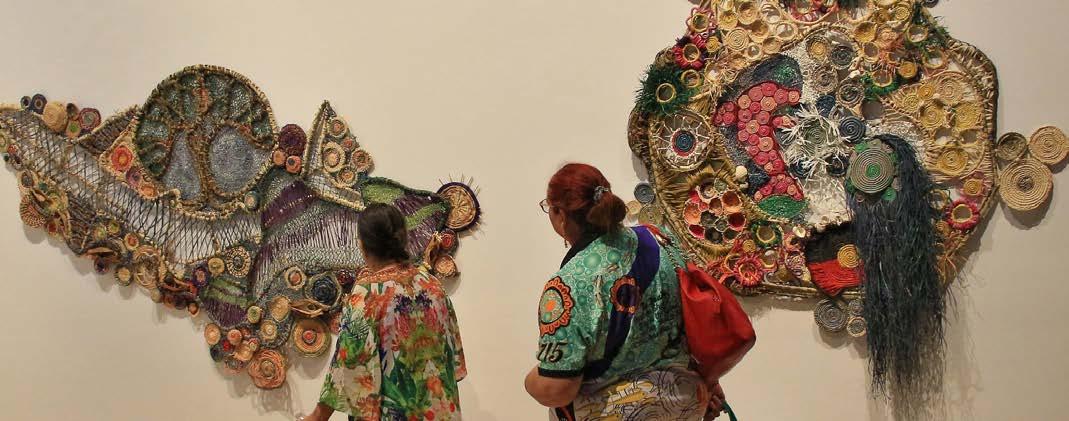
TIMEFRAME PROGRAM
& LINKAGES ROLE
PRIORITY ACTIONS
PARTNERS
30 MidCoast Destination Management Plan 2030
Action 2.2 Implement a product and experience development program
2.2.1 Implement an experience and product development program focused on enhancing existing and developing new experiences, products, accommodation and events. Include consideration of but not limited to:
• Revitalisation of existing accommodation and hospitality
• Improving customer service standards to meet the needs and expectations of visitor markets
• Strengthen the supply of agritourism experiences as well as encouraging the increased use of local produce
• Addressing the needs of accessible tourism as well as more pet-friendly accommodation and enhancing the supply and quality of more-interactive interpretation
• Experience packaging, bundling and multiday itinerary development to meet the needs of difference target market segments. Develop and offer more paid experiences and ensure they are listed through online distribution partners
• Continuing to grow the listing of products on the ATDW, including linking with DNSW’s NSW First, Get Connected and export-ready programs
2.2.2 Encourage an increase in the supply and diversity of sustainable tourism, including ecoaccredited accommodation, experiences and products
2.2.3 Connect major industry tourism operators with local tourism and hospitality providers, including private air charters and international-ready partners or wholesale operators, including rental car companies (especially those that specialise in RV and campervans)
•
•
•
•
PRIORITY ACTIONS TIMEFRAME PROGRAM PARTNERS & LINKAGES ROLE
Commence 2024-25 Then ongoing
Industry Advisory Group
•
DNC & DNSW
Department of Primary Industries
Department Planning Lead Support Facilitate
Ongoing
Industry
Ecotourism Australia Advocate Facilitate
•
•
2024-25
Industry Advisory Group and broader industry
•
DNSW
DNC Advocate Facilitate 31 MidCoast Destination Management Plan 2030
•
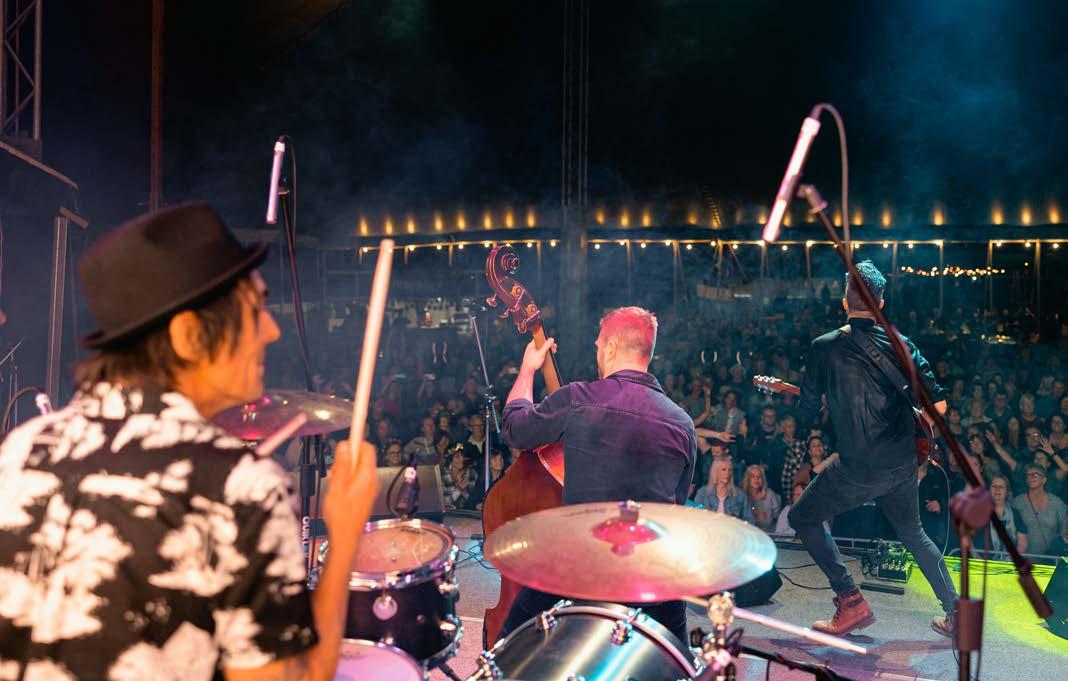
2.3.1 Review and update the MidCoast Events & Festivals Sponsorship Policy to consider:
• Creating a framework that distinguishes between the different types of events, by primary objectives or outcomes to be achieved, for example:
Community and local events
Major events
Sport events
Signature events
• Addressing seasonality
• Achieving a balance between attracting new markets and maintaining or growing existing ones
• Integrating sport and outdoor recreation events as part of activating future development of sporting and outdoor recreation facilities and infrastructure
PRIORITY ACTIONS TIMEFRAME PROGRAM PARTNERS & LINKAGES ROLE Action 2.3 Attract new events and help build capacity of local events
Review 2023-24 Implement 2024-25 • Industry • DNC & DNSW • Regional Sporting Precinct Development Strategy and Master Plan Lead 32 MidCoast Destination Management Plan 2030
2.3.2 Develop a strategic approach to attract business and private events to the region
• Initial focus (short to medium term) on small-scale and boutique business and private events
• Encourage event venue (indoor and outdoor) owners and/or managers to ensure they are listed as a venue on ATDW and Meet in Regional NSW website
• Collaborate with DNC as well as HJO and participate as part of HJO’s Events 10 project to attract events to the wider HJO region and leverage the power of the collective voice in market
2024-25
• Industry
• DNC & DNSW Lead
2.3.3 Identify priorities for sport and outdoor recreation events linked to core attributes of the sub-regions
Ongoing
• Involve local sporting associations & groups
• DNC & DNSW
• DRNSW
Lead
Action 2.4 Attract investment for infrastructure and facilities that deliver shared benefits for residents and visitors
2.4.1 Attract investment for and implement priorities identified within MidCoast Council’s existing plans, strategies and initiatives
Ongoing
• MidCoast Council-lead
• Links to:
Draft MidCoast Local Environmental Plan 2024
MidCoast Open Space & Recreation Strategy 2023 - 2035
Regional Sports Hub (Redevelopment of the Taree Sports Grounds)
Figtrees on the Manning Future initiatives, including those outlined in the Local Strategic Planning Statement
Lead Facilitate
PRIORITY ACTIONS TIMEFRAME PROGRAM PARTNERS & LINKAGES ROLE
33 MidCoast Destination Management Plan 2030
2.4
2.4.2 Prioritise future place planning or masterplans for revitalisation of town centres and to facilitate connectivity to the region’s nature-based assets as well as activate waterways, including rivers, lakes and foreshore access:
• Identify and prioritise connectivity with core features of the destination, including towns and villages, waterways and all elements of the experience - from accommodation to tours, attractions, retail and hospitality through to amenities and services such as parking and toilets
• Integrate initiatives to facilitate enhanced waterway access both on to and from the water, including to support water-based tours and activities through to potential for seaplane docking on Wallis Lake – a core stakeholder to engage is Crown Lands NSW
• Support opportunities for adaptive reuse of heritage sites that enable activation of those sites for community and visitor-related purposes, such as retail, accommodation or events
• In the above context, prioritise master and place planning for Tea Gardens –Hawks Nest, especially revitalisation of the foreshore and enhancing connectivity (future game-changer project) – Crown Lands NSW will be a key stakeholder in this initiative
Ongoing
• Links to:
Draft MidCoast
Local Environmental Plan 2024
MidCoast
Open Space & Recreation
Strategy 20232035
Regional Sports Hub (Redevelopment of the Taree Sports Grounds)
Figtrees on the Manning
Future initiatives, including those outlined in the Local Strategic Planning Statement
Lead
2.5.1 Provide incentives and support for sustainable tourism developments, including accommodation and experiences through the development application (DA) process and place or master planning initiatives undertaken by Council
Ongoing
PRIORITY ACTIONS TIMEFRAME PROGRAM PARTNERS & LINKAGES ROLE
Action
Attract investment for infrastructure and facilities that deliver shared benefits for residents and visitors continued
Action 2.5 Attract investment in sustainable, nature and cultural tourism experiences, accommodation, and hospitality
34 MidCoast Destination Management Plan 2030
Lead Advocate
2.5.2 Profile existing sustainable tourism products, experiences and accommodation on all consumerfacing channels for marketing
Barrington Coast
Ongoing
• Tourism industry
Action 2.6 Encourage diversification and revitalisation of accommodation supply
2.6.1 Develop an accommodation supply roadmap/action plan that addresses the revitalisation of existing accommodation as well as attracting investment for new accommodation (including different styles and types of accommodation)
Establish
2024-25
• DNC - North Coast Accommodation Strategy
• Industry Advisory Group
Lead
Lead Advocate
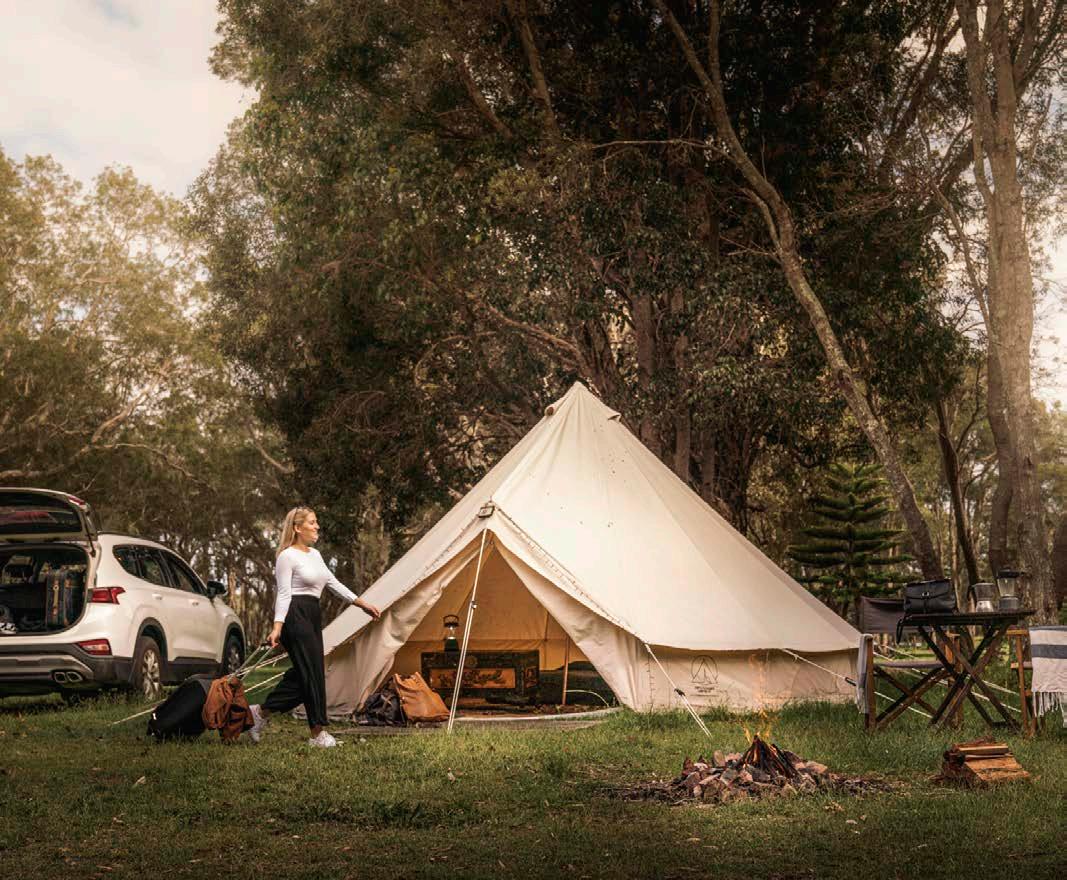
PRIORITY ACTIONS TIMEFRAME PROGRAM PARTNERS & LINKAGES ROLE
35 MidCoast Destination Management Plan 2030
Action 2.7 Game changer projects for the region
2.7.1 Subject to available resources, assist with completing / complete robust business cases and feasibility studies and attract investment for long-term game-changer projects for the region. This can include:
• Forster 360 Walk
• Gathang Cultural Centre and Regional Art Gallery
• Mara Wakulda ‘Come Together’ Project
• Kiwarrak State Forest Mountain Bike Park
• Great Lakes Great Walk and Aquatic Trails project
• Adventure Hub in Gloucester
• Mountain Maid gold mine visitor precinct
2.7.2 Identify and progress wild river access points within the hinterland areas of the region – this would support increased access for naturebased activities and tours (paid experiences as well as access for recreation)
As opportunities arise
• Industry Advisory Group
• Industry
• NSW Government agencies as appropriate to each project
The NSW Government’s cost benefit analysis framework provides an important step towards effective business case development and feasibility assessment, essential to progress these projects – it is referenced in the Destination North Coast DMP 2022 – 2030, Appendix 2
Support
Investigate 2024-25
Facilitate
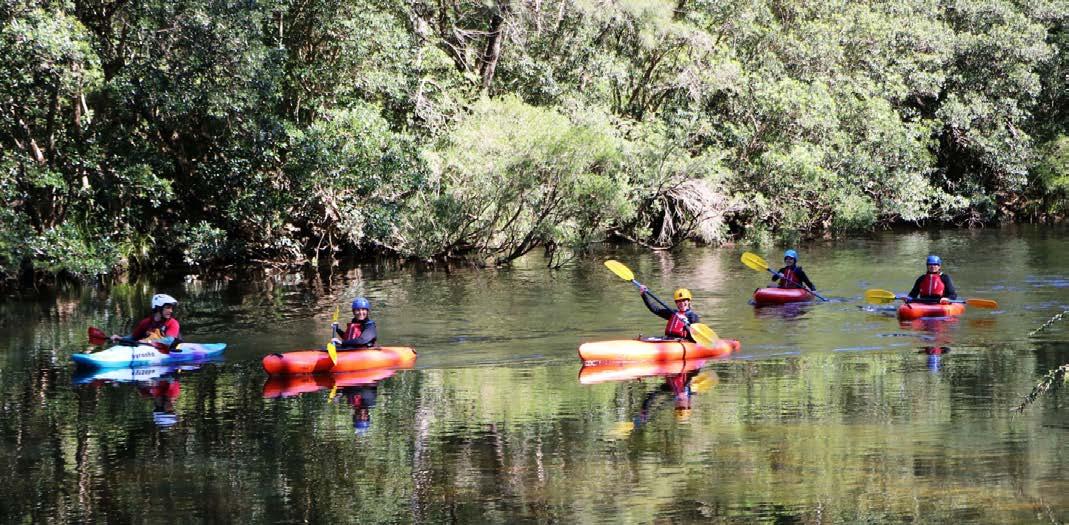
PRIORITY ACTIONS TIMEFRAME PROGRAM PARTNERS & LINKAGES ROLE
36 MidCoast Destination Management Plan 2030

2.7.3 Upgrade and maintain road access to key nature-based attractions such as Ellenborough Falls as well as to profile access to the region via Thunderbolts Way
2.7.4 Where possible and appropriate, work with the private developer on the potential adaptive reuse of Gloucester’s Old Butter Factory (subject to the site’s constraints and investment)
2.7.5 Support other significant visitorrelated projects on lands managed by NSW Government agencies, including NPWS, Forestry Corporation and Crown Lands NSW, especially to enable connectivity at a landscapescale
Ongoing Lead
As opportunities arise
Facilitate
As opportunities arise Support
ACTIONS
PROGRAM PARTNERS & LINKAGES ROLE
PRIORITY
TIMEFRAME
37 MidCoast Destination Management Plan 2030
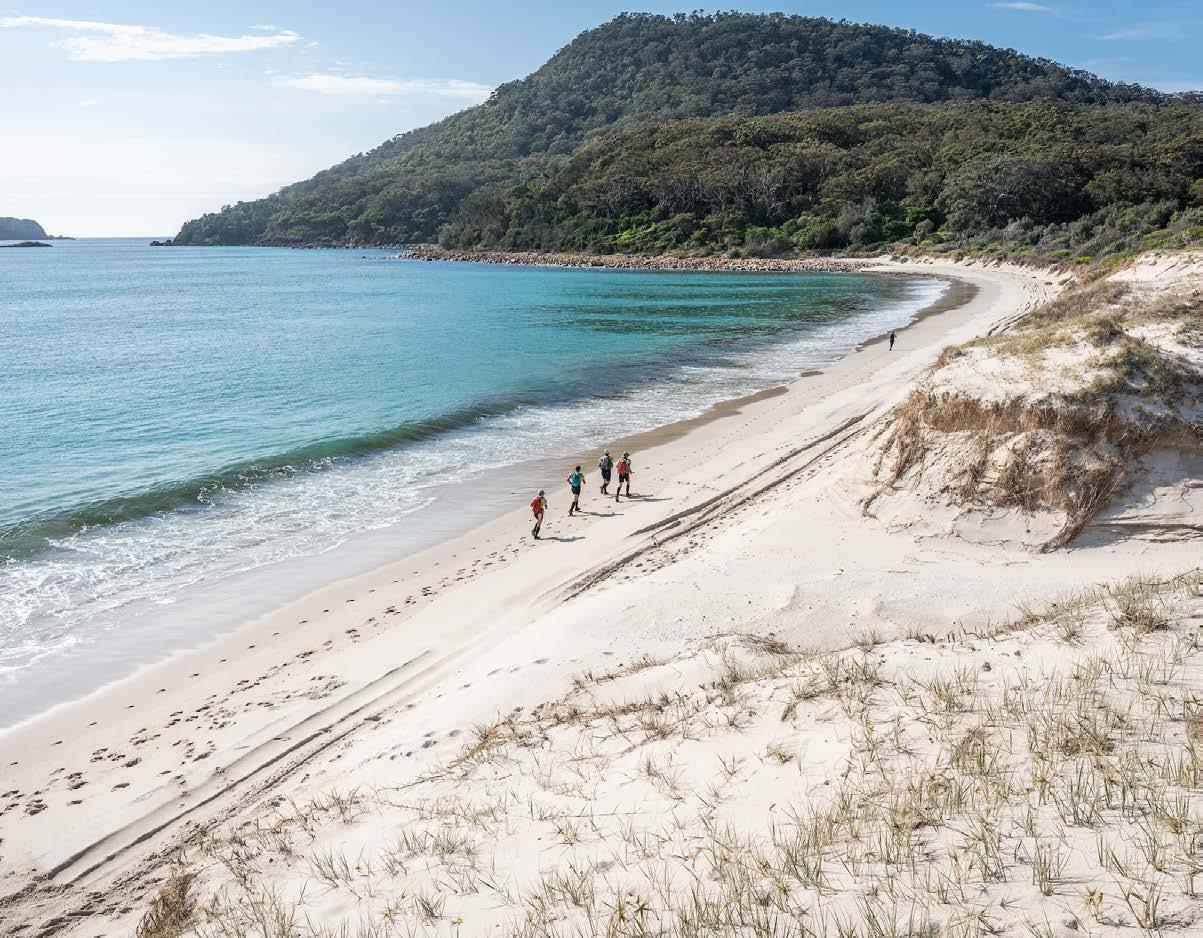
Demand
Tourism for the MidCoast is an important factor in driving economic growth for the region. For the year ending December 2022, the MidCoast welcomed over 2 million visitors, equating to over $900M in expenditure in the region. In terms of the greater North Coast Destination Network, this is a 17% share of the overall visitor market (The Value of Tourism to North Coast, 2022).
As destinations move towards the end of the ‘recovery phase’ at the end of 2024, to return to preCOVID levels of visitor expenditure, a focus on planning for the ‘momentum phase’ from 2024 – 2026 will be critical for the MidCoast as demand will likely increase.
High level objectives
1. Increase low and shoulder season as well as encouraging mid-week visitation
2. Increase overnight visitor yield, year-round
3. Encourage greater regional dispersal
Priority actions to address these high-level objectives are shown in the action plan following:
38 MidCoast Destination Management Plan 2030
Action 3.1 Continued commitment to the Destination Barrington Coast brand and positioning, Blaze your own trail
3.1.1 Leverage core insights into the target market segments and historical campaign data to inform and evolve the Destination Barrington Coast brand
• Strengthen the narrative relating to each of the core areas or subregions to reinforce their points of difference or character while maintaining consistency in the way in which Barrington Coast is marketed
Ongoing
• Industry Advisory Group
• Industry Lead
Action 3.2 Create a destination marketing plan to guide all marketing and marketingcommunication activities
3.2.1 Develop a multi-year marketing plan to guide marketing campaigns, content creation, and other activities across owned, earned, and paid channels to reach the target market segments
2024-25
• Tourism industry
• Business Chambers
• Industry Advisory Group
• DNSW Lead

ACTIONS TIMEFRAME PROGRAM PARTNERS & LINKAGES ROLE
PRIORITY
39 MidCoast Destination Management Plan 2030
Action 3.3 Raise the awareness of the Destination Barrington Coast brand with local businesses and community
3.3.1 Engage the local community on the rationale for and benefits of the MidCoast tourism brand, Destination Barrington Coast
3.3.2 Recognise and encourage operator excellence through programs such as NSW Tourism Awards
2024-25
• Industry Advisory Group
• DNC Lead
Ongoing
• DNC
• DNSW
• Industry Advisory Group Facilitate Support
Action 3.4 Continue to deliver visitor services across the region
3.4.1 Review the current mobile pop-up visitor information program to deliver a more strategic approach to dispersed regional visitor servicing
3.4.2 Review and enhance the Business Partnership and Information Program
3.4.3 Continue to create and distribute relevant content, including packages for multichannel distribution, including but not limited to:
• Itinerary packaging tailored to relevant market segments
• Strengthening support for events at specific touchpoints on the customer journey: prearrival, in-region and post-visit
3.4.4 Implement refreshed and consistent wayfinding and welcome signage as well as interpretation and dual naming opportunities. Consider the use of digital signage
2024-25
• Tourism Industry
• Business Chambers
• Industry Advisory Group Lead
2025-26 Lead
Ongoing
• Industry Advisory Group Lead
2025-26 Lead
Strategy 3.5 Continue to support the growth of the Visiting Friends & Relatives (VFR) market
3.5.1 Continue to implement a hyper-local campaign, to activate residents to invite their friends and relatives (VFR market) to visit in the low or shoulder season
Ongoing
• Industry Lead
PROGRAM
& LINKAGES
PRIORITY ACTIONS TIMEFRAME
PARTNERS
ROLE
40 MidCoast Destination Management Plan 2030
Appendix: Situation Analysis

04

DMP2030 has been informed by a comprehensive situation analysis, including global and domestic trends, visitor research and range of existing local, state and national strategies and policies, including the following. The consultant that undertook the research (Destination Marketing Store) has provided the following information, which helped to shape DMP2030.
42 MidCoast Destination Management Plan 2030
NSW Visitor Economy Strategy 2030
NSW Visitor Economy Strategy 2030 (VES) sets a target to triple 2009 overnight visitor expenditure in NSW by 2030, surpassing previous targets despite recent challenges. There are specific targets set for regional NSW as well as for domestic tourism:
• Regional Overnight Visitor Expenditure: $25B by 2030 (from $20.5B in 2019)
• Total Domestic Visitor Expenditure: $47B by 2030 (from $31.9B in 2019)
Five strategic pillars underpin the NSW Government’s vision to be the premier visitor economy in the Asia-Pacific by 2030.
It identifies five guiding principles (one of which is provided below) as well as three core phases: Recovery (to 2024); Momentum (to 2026); and Accelerate (to 2030).
Strategic Pillar 3 of the VES is about showcasing our strengths – both our existing strengths and emerging ones. From vibrant contemporary culture, reconnecting with nature and small-town charm through to events and eco-wellbeing, there are significant opportunities for MidCoast to contribute to the regional NSW VES targets.
For further information see: https://www.destinationnsw.com.au/about-us/strategies-and-plans/ visitor-economy-strategy-2030
Guiding Principle 1: Put the visitor first
We have put visitors front and centre of this strategy to enable better targeted marketing, experience design and industry support through a greater understanding of potential visitors. Every visit should be an unforgettable one that inspires and encourages visitors to keep exploring and returning to NSW. Consumer trends and visitor needs will inform experience design, event development, infrastructure investment and marketing. This visitor-centric approach will involve: › A deep understanding of the needs and aspirations of potential visitors › Tracking and analysis of evolving consumer preferences and trends › A dynamic market prioritisation and segmentation approach › Working with industry to deliver exceptional visitor experiences › Personalised marketing and communications to guide visitors to experiences in NSW that match their specific interests and needs and encourage them to return. (NSW VES 2030, page 28)

43 MidCoast Destination Management Plan 2030
Destination North Coast’s Destination Management Plan 2022 - 2030
Destination North Coast NSW’s Destination Management Plan 2022 – 2030 (DNCDMP) was released in early 2023. DNC is an important conduit between the NSW Government, local government, tourism organisations and businesses. DNC’s primary role is to coordinate tourism-related strategies and projects that promote the growth and prominence of the visitor economy across the region. They do this by delivering regional funding and industry development programs and identifying infrastructure needs and investment opportunities.
DNC’s priorities align with the objectives, strategies, and commitments of the NSW Government and are facilitated in partnership with government agencies, tourism organisations, and operators, guided by the DNCDMP.
The DNCDMP incorporates:
• Clear vision for North Coast NSW: To sustainably grow yield of visitors to North Coast NSW supporting the regional NSW goal of generating $25B by 2030, without compromising the distinct natural beauty and communities that makes the region so unique
• A set of strategic objectives and an associated plan of action from 2022 to 2030, reflecting current market trends and local priorities, and aligning with NSW Government’s Visitor Economy Strategy 2030
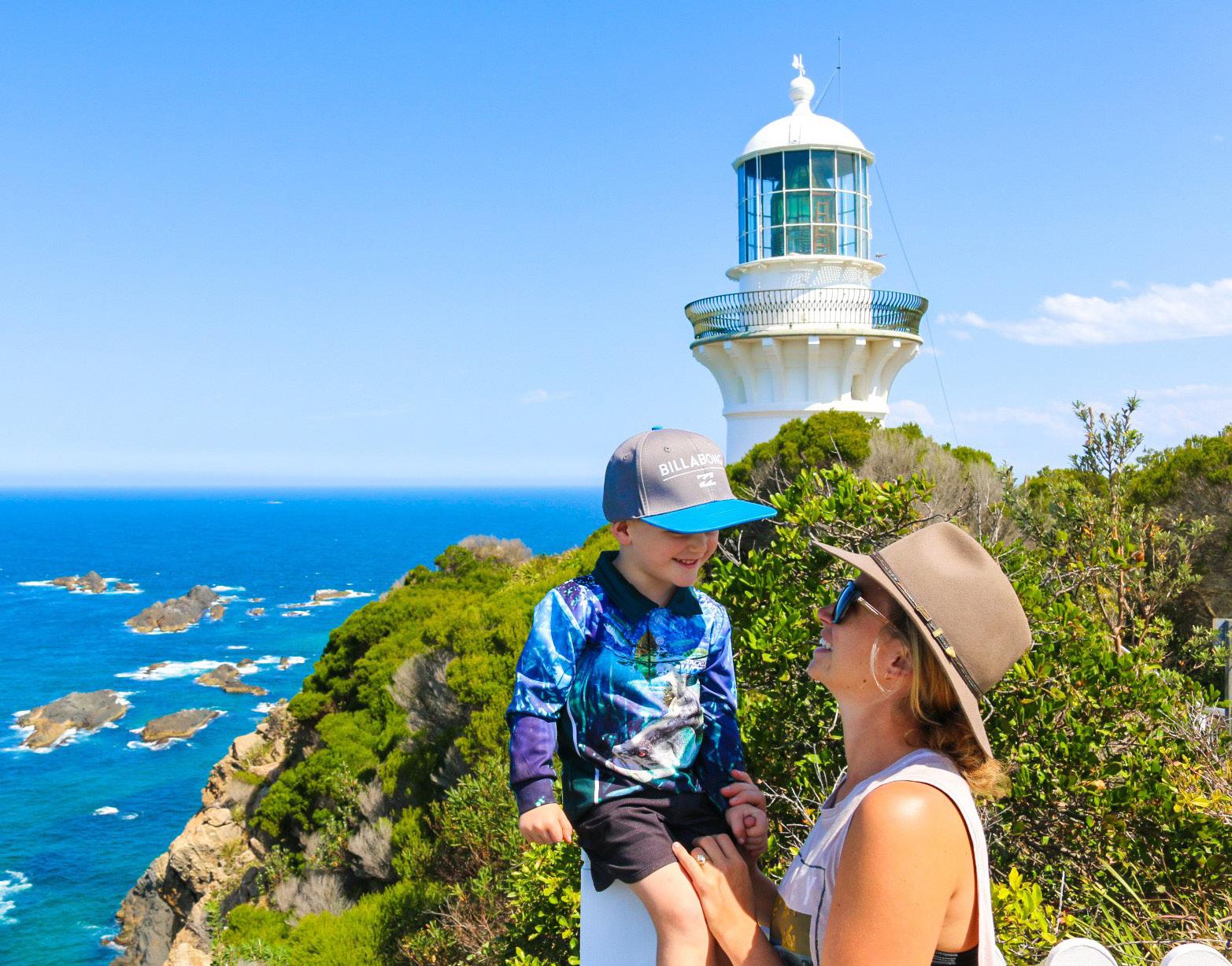

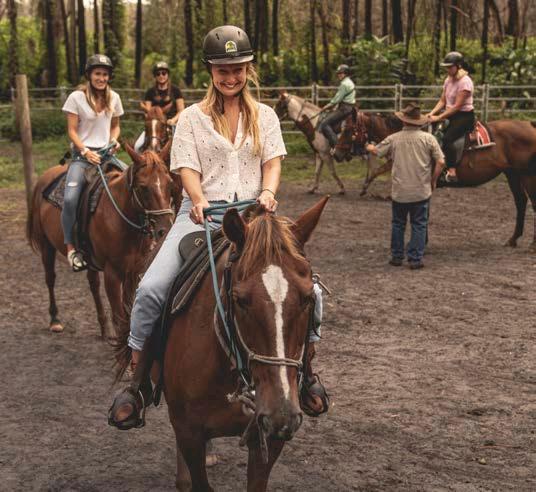
Primary actions specifically relevant to MidCoast Council:
• Create distinctive experience trails and itineraries related to positioning strengths of the region
• Advocate and support the development of new heritage and First Nations products and experiences including tailored industry development and support to help bring forward new cultural tourism product development opportunities
• Further develop agritourism and produce product development opportunities to enhance the region’s food bowl reputation
• Advocate and support development of experiences and infrastructure that will drive visitation by improving access to and activation of the region’s waterways as critical visitor assets
• Enhance the caravan, camping and RV sector maintaining North Coast NSW market leading position and address the shortage of contemporary and creative family focused product within the region
• Attract and deliver events either independently or collaboratively that have the capacity to grow visitation to the region and securing key new events that have the potential to be amplified to attract increased or new audience segments
• Support the attraction and continued development of participatory sporting events and advocate for regional hosting of training camps and sporting events including for the 2032 Olympic and Paralympic Games
• Continue to build momentum in strategically attracting business events to the region
• Grow the quantity, diversity, and quality of accommodation across the region
• Advocate to the Australian and NSW Government to improve digital and transport connectivity
• Leverage opportunities for international and domestic airway route development and to improve the visitor experience
• Facilitate capacity building programs to enhance operator knowledge and engagement with sustainability principles
For further information see: https://dncnsw.com/strategies-and-plans/
45 MidCoast Destination Management Plan 2030
Target Markets
Understanding the motivations, preferences and interests of your target market segments as well as addressing barriers to travel is critical to success as its about building an understanding of who and why people would be interested in choosing your destination for their holiday or travel.
Demographic market segments can be a useful guide. However, to really understand your target markets, it is important to consider psychographic profiles. This is because not everyone in a demographic market has the same motivations, interests, preferences, or even budget. Even in special interest activities, such as mountain biking, we find important differences in the characteristics and behaviours of the market across various segments.
The relationship between psychographic market segments (the ‘common ground’) and demographic market segments as well as generational influences (for example, between Gen Z, Millennials, Gen X and Baby Boomers) and their mindset are important (for example,
are they travelling as a family, a group of close friends, as a couple or to attend an event or wedding).
Another key consideration is the aspirational target market that has underpinned the destination brand strategy and subsequently the success of Destination Barrington Coast’s campaign, Whatever it takes/ Who cares if. Contemporary women travellers were initially identified as a high priority target market within the MidCoast DMP 2017. It has continued to grow and strengthen as a target audience while also remaining highly relevant to the region, especially when considering the generational market segments and mindset for travel.
Psychographics
- shared values, motivations + behaviours
DemographicsGenerational, social + cultural influences
Domestic Markets – by geographical source
International Markets – by geographical source
46 MidCoast Destination Management Plan 2030
The high-level objectives for the target markets have largely remained unchanged since identified for the MidCoast DMP 2017. The reason is that they continue to be relevant, if not moreso. A minor change is to emerging markets (described as new markets in the MidCoast DMP 2017), where the focus on visitor numbers has been removed with greater emphasis on attracting these markets during non-peak season. This is consistent with the MidCoast Economic Development Strategy 2023 - 2028. However, what has changed more significantly is the profile of the existing and emerging markets.
High-level objectives:
1. Existing markets – strengthen appeal of the destination to existing markets to:
• Extend length of stay
• Encourage repeat visitation
• Increase participation in tours and activities (paid experiences)
• Increase regional dispersal (especially during peak coastal periods)
These have been updated based on a detailed review of contemporary visitor markets, which is summarised on the following pages. Below is an updated diagram, which provides a summary of existing markets and emerging markets. The approach represents the sweet-spot between psychographic and demographic or generational market segments. It leverages the existing and emerging strengths of the region. It should also be noted that the emerging markets are already arriving – while they could be classified as ‘existing’ they are still an emerging market opportunity for the region.
2 Emerging markets – focus on those markets with greatest propensity to grow the visitor economy:
• Increase visitation during non-peak periods
• Increase yield (through development of higher-yield experiences and accommodation offer)
The strategic approach is to maintain existing markets but also target emerging, higher-value markets
Existing Markets
Traditional family holidays; Visiting friends and relatives; Event participants (incl. sports); Active 55+ (this market continues to evolve).
Emerging Markets
Active families (Millennials); Wellness tourism market (especially women); Younger adults (Gen Z); Work from anywhere market.
47 MidCoast Destination Management Plan 2030

The following psychographic market segments have been identified by Tourism Australia in their Future of Global Tourism Demand report (November 2022). These segments have been identified following extensive research undertaken by Tourism Australia through their Consumer Demand Project. Importantly, they include the domestic market in Australia.
It is proposed that these market segments are also considered within the new DMP. However, the use of these psychographics is not intended to be exclusive nor replace the more traditional visitor markets for Barrington Coast, including the family market. In fact, they assist in evolving our understanding of these markets in a more contemporary way.
Tourism Australia’s psychographic market segments:
• Reconnection Traveller: motivated to spend time with loved ones. It’s about relaxing and escaping the daily grind of their everyday lives, having fun, and enjoying themselves
• Into Nature Traveller: they want to escape, to feel secure and comfortable, to have a sense of adventure and have a focus on mental and/or physical wellbeing
• Exploration Traveller: is motivated to explore new destinations and to learn and experience new things. This traveller is a key target audience for Indigenous tourism experiences as well as cultural institutions and attractions
• Adventure Traveller: travel for enjoyment, fun, and a strong sense of adventure. They’re keen to meet new people, make friends and challenge themselves. They have a need for stimulation and escape. They connect with remoteness and ruggedness but are also activity oriented
• Wellness Traveller: they are looking for destinations and experiences to nourish their body, mind, and soul to stave off burn-out and fatigue. They are looking to reset, to re-equilibrate and re-centre; they seek travel that relaxes the mind, slow travel; and screenless solitude
48 MidCoast Destination Management Plan 2030
These psychographic market segments are also more likely to be interested in the experience offer and competitive advantage of the MidCoast region while they are also more likely to be high value travellers, which provides opportunities for increasing yield as well as travel outside of peak season (year-round).
There are four additional influences on travel choice worth considering:
• Upping the ante on food and drink: travellers are seeking culinary adventures, to sample authentic cuisines, ingredients, and drinks … to dive into a kaleidoscope of flavours, textures, and the stories of people, process and place that go into them.
• Sustainability: Sustainability is at the front and centre of the global psyche, shaping demand for low carbon footprint travel options and experiences that touch the earth and its communities lightly, leaving places and people better off than when they arrived. More than 75% of travellers are committed to sustainability in some way. Sustainability is increasingly influencing traveller choices in terms of where to go, how to get there, where to stay, and which experiences they engage with at the destination.
• Indigenous tourism: Indigenous businesses and Indigenous-led partnerships will be critical to meeting demand in a way that balances respect with best-practice customer experiences. An Indigenous lens can value-add when paired with appealing experiences that play to Australia’s strengths: natural environment, wildlife, coastal and agritourism.
• Accessibility: travellers with accessibility needs are seeking a range of experiences and are more often travelling for adventure, transformation, and to engage in passions. Accessibility goes beyond physical or visibly noticeable impairments and extends into mobility, visual, audio, or cognitive impairment. This is even more important given 2023 is the Year of Accessible Tourism.
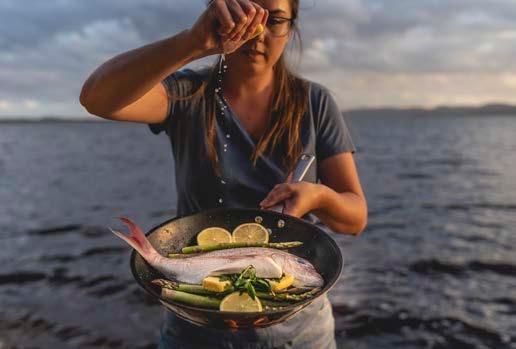


49 MidCoast Destination Management Plan 2030

Additional Market Segment Considerations
There are several market segments where significant growth is expected to continue both within Australia and around the world, including:
• Continuing rise in the numbers of contemporary female travellers, who are more likely to have a higher disposable income and to travel either on their own or in small groups of friends. They are also key influencers in family travel and seek new experiences that immerse them in the destination and local culture.
• The continuing evolution of the fifties plus market. More people are choosing to travel earlier than retirement to enjoy the more active or immersive experiences that destinations have to offer. Globally, the 55+ market has the highest disposable income and are seeking new destinations to add to their bucket-list. They are as equally excited about an Australian holiday as they are about an overseas trip. This market is largely misunderstood; they want to engage and be part of the ‘local scene’. They are also much
more active and want to be perceived as being ‘young at heart.’ Domestically, they are also looking for short-break escapes and often choose to travel outside of peak periods to avoid the crowds.
• Active families are attracted to a destination that offers happy, healthy, sustainable and safe family adventure. This trend has seen a significant growth in more recent years, particularly following the COVID-19 travel restrictions and lockdowns. They seek opportunities for their children to experience the great outdoors and self-select a break from screen time by providing a fun and exciting alternative. This increasingly includes short breaks as well as aligning with the significant growth in demand for caravan, campervan and camping accommodation and facilities. The MidCoast region is well positioned to offer this type of holiday.

51 MidCoast Destination Management Plan 2030
• Millennials and Gen Z continue to travel more domestically than previous generations of their age. This market is highly likely to be attracted to the region as they seek more sustainable, nature-based destinations that offer a variety of accommodation, quality food and drink and contemporary arts and culture. They travel in couples or small groups of close friends, avoid older-style youth hostels and desire to experience a destination ‘like a local’ (ie seek out local experiences). Millennials are also travelling with their young families and seek out more experiential travel opportunities that engage the whole family, including through increased demand for camping, caravan and campervan and short-term rental accommodation.
• Digital nomads and the remote working revolution. Even though this market is relatively small it is growing rapidly. This market is seeking places that have connectivity (for ease of remote working), opportunities for short-term rental accommodation and co-working space, as well as activities and experiences to do while they are in the region. They can also create short term VFR opportunities. The remote working market want to feel like a local for the time they are in your town, village, or region. They want to be part of the community and short-term rental accommodation is high on their list of accommodation choices/options. A recent study from Accenture on the future of work found that 63% of highgrowth companies have already adopted a ‘productivity anywhere’ workforce model. A large share of travellers surveyed for the 2022
SKIFT Report - Sustainability and Remote Work
Shaping the Future of Travel, state that being able to work remotely will be a major factor in their future job decisions.
• Cycle tourism and mountain bike market segments – there is an increasing interest throughout Australia in opportunities for cycle tourism. A common misperception is that all riders are the same. This is not the case, even among mountain bikers there are significant differences (as opposed to other forms of cycle tourism).
• Given the recent investment in mountain bike trails in the region, there is an opportunity for Destination Barrington Coast to further strengthen it’s appeal to cycle tourism markets, especially for mountain biking and gravel bikes. However, it will be important to consider who the target audience should be. For mountain biking, it is most likely the mountain biking leisure segment, who are more likely to have a mountain bike experience while taking a holiday. However, specific experiences such as those associated with Kiwarrak State Forest Mountain Bike Park and The Steps Barrington and Barrington Bike Park are more likely to attract the mountain bike enthusiast segment, who will travel for the primary purpose of a mountain bike experience.
A further consideration is the opportunity for collaboration with HJO on the development of the Hunter Cycle Tourism Strategy, which will incorporate MidCoast Council region.

52 MidCoast Destination Management Plan 2030

Abbreviations used in this document
ATDW: Australian Tourism Data Warehouse
DMP: Destination Management Plan
DMP2030: MidCoast Destination Management Plan 2030
DNC: Destination North Coast NSW
DNSW: Destination NSW
DRNSW: Department of Regional NSW
HJO: Hunter Joint Organisation
LALC: Local Aboriginal Land Council
NATOC: NSW Aboriginal Tour Operators Council
NPWS: National Parks & Wildlife Service
TIDE: Taree Indigenous Development & Enterprise
VFR: Visiting Friends and Relatives
53 MidCoast Destination Management Plan 2030
midcoast.nsw.gov.au









































